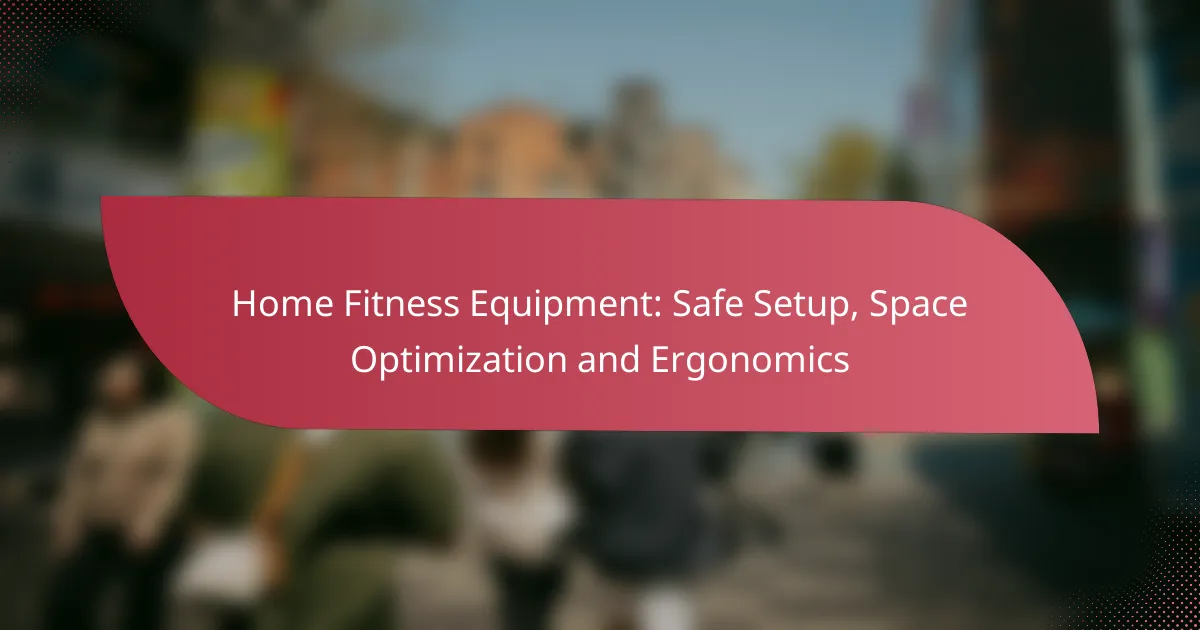Creating a safe and efficient home fitness environment requires careful consideration of equipment setup, space optimization, and ergonomic adjustments. Properly preparing your workout area and adhering to safety standards will enhance both functionality and safety. By utilizing smart storage solutions and ensuring your equipment is tailored to your body, you can maximize your workout potential while minimizing the risk of injury.

How to safely set up home fitness equipment?
To safely set up home fitness equipment, ensure that the space is properly prepared and that all equipment is installed according to safety standards. This includes using appropriate flooring, following manufacturer guidelines, and ensuring adequate ventilation.
Use proper flooring materials
Choosing the right flooring is crucial for safety and equipment longevity. Use materials like rubber or foam mats that provide cushioning and grip, reducing the risk of slips and falls. Avoid hard surfaces like tile or concrete, which can lead to injuries.
Consider the type of workouts you’ll be doing. For high-impact activities, thicker mats may be necessary, while lighter workouts might only require basic padding. Ensure the flooring is level to prevent wobbling equipment.
Follow manufacturer guidelines
Always adhere to the manufacturer’s instructions for setup and usage of fitness equipment. These guidelines provide essential information on installation, weight limits, and safe operation practices. Ignoring them can lead to accidents or equipment damage.
Check for specific requirements such as spacing around machines and recommended usage times. Following these guidelines helps ensure that your equipment functions safely and effectively.
Ensure adequate ventilation
Proper ventilation is vital for a safe workout environment. Ensure that your fitness area has good airflow to prevent overheating and to maintain air quality. Open windows or use fans to circulate air, especially during intense workouts.
Adequate ventilation also helps reduce humidity, which can lead to mold growth and equipment deterioration. Aim for a temperature range that feels comfortable, typically between 20-22°C (68-72°F).
Install safety mats
Safety mats are essential for protecting both the floor and the equipment. They can absorb shock and reduce noise, making your workouts quieter and safer. Place mats under heavy machines like treadmills or weight benches to prevent damage to your flooring.
Look for mats that are specifically designed for fitness equipment, as they offer better durability and grip. Regularly check these mats for wear and replace them if they show signs of damage.
Check electrical safety for machines
For electrically powered equipment, ensure that all electrical connections are safe and compliant with local regulations. Inspect cords for fraying and ensure that outlets can handle the equipment’s power requirements without overloading.
Using surge protectors can help safeguard your machines from power surges. Regularly check that all machines are properly grounded to prevent electrical hazards during use.

What are the best space optimization strategies for home gyms?
Effective space optimization strategies for home gyms focus on maximizing available area while ensuring functionality and safety. By implementing smart storage solutions and selecting versatile equipment, you can create an efficient workout environment in limited spaces.
Utilize vertical storage solutions
Vertical storage solutions help you make the most of your wall space, keeping the floor area clear for workouts. Consider wall-mounted racks, shelves, or hooks to store weights, resistance bands, and yoga mats. This approach not only saves space but also makes equipment easily accessible.
Use clear bins or labeled containers to organize smaller items. This way, you can quickly find what you need without cluttering your workout area. Aim for a tidy setup that promotes a focused exercise routine.
Incorporate multi-use equipment
Multi-use equipment is essential for maximizing functionality in a compact home gym. Look for items like adjustable dumbbells, resistance bands with varying levels, or a bench that can be used for multiple exercises. This versatility allows you to perform a wide range of workouts without needing excessive gear.
Consider investing in a power rack that can accommodate squats, bench presses, and pull-ups. This type of equipment can replace several machines, saving both space and money while providing a comprehensive workout experience.
Designate a flexible workout area
Creating a flexible workout area allows you to adapt your space based on your needs. Choose a room or corner that can easily transform into a gym, using mats or flooring that can withstand various activities. Ensure there’s enough room to move freely without obstruction.
Consider using furniture that can be easily moved or rearranged. For example, a foldable table or chairs can be stored away when it’s time to exercise, allowing for a spacious environment. This adaptability is key in smaller homes.
Consider foldable or compact machines
Foldable or compact machines are ideal for home gyms with limited space. Look for treadmills, exercise bikes, or rowing machines that can be easily folded and stored after use. These machines often provide the same functionality as traditional equipment but take up significantly less room.
When selecting compact machines, check their weight capacity and stability to ensure safety during workouts. Investing in quality equipment that meets your space requirements will enhance your exercise routine without sacrificing performance.

How to ensure ergonomic setup for home fitness?
To ensure an ergonomic setup for home fitness, adjust your equipment to fit your body dimensions and maintain proper posture during workouts. This approach minimizes the risk of injury and enhances comfort, allowing for more effective exercise sessions.
Adjust equipment to fit body dimensions
Adjusting fitness equipment to match your body dimensions is crucial for preventing strain and injury. For instance, when using a stationary bike, ensure the seat height allows your knees to have a slight bend at the bottom of the pedal stroke. Similarly, when using weights, choose a weight that allows you to maintain proper form without overexertion.
Check the manufacturer’s guidelines for recommended adjustments, and consider using a measuring tape to ensure accuracy. Regularly reassess your setup, especially if you change your workout routine or body size.
Maintain proper posture during workouts
Maintaining proper posture during workouts is essential for maximizing effectiveness and minimizing injury risk. Keep your back straight and shoulders back, whether you are lifting weights or performing cardio exercises. For example, when doing squats, ensure your knees do not extend past your toes to protect your joints.
Utilize mirrors or video recordings to monitor your form. If you notice any discomfort or strain, pause to adjust your posture before continuing your workout.
Use ergonomic accessories
Incorporating ergonomic accessories can significantly enhance your home fitness experience. Items like padded mats, adjustable benches, and supportive footwear can improve comfort and stability during workouts. For example, a good quality yoga mat can provide cushioning for floor exercises, reducing the risk of injury.
Consider investing in accessories that promote natural body alignment, such as resistance bands or stability balls, which can also help engage your core muscles effectively.
Incorporate adjustable furniture
Using adjustable furniture in your home gym can facilitate an ergonomic setup. Adjustable benches, for example, can be modified for various exercises, allowing you to maintain proper alignment and comfort. Similarly, a height-adjustable desk can help transition between workouts and office tasks seamlessly.
When selecting furniture, look for options that allow for easy adjustments and support a range of activities. This flexibility can enhance your overall fitness routine and encourage regular movement throughout the day.

What are the essential home fitness equipment types?
Essential home fitness equipment types include cardio machines, strength training equipment, functional training tools, and yoga and flexibility gear. Each category serves a specific purpose, catering to different fitness goals and preferences.
Cardio machines like treadmills
Cardio machines, such as treadmills, are designed to improve cardiovascular health and endurance. They allow users to engage in aerobic exercise, which can help burn calories and enhance overall fitness levels.
When choosing a treadmill, consider factors like motor power, running surface size, and built-in workout programs. A good treadmill typically offers a motor of at least 2.5 HP for effective performance and durability.
Strength training equipment
Strength training equipment includes free weights, resistance bands, and weight machines, all aimed at building muscle strength and endurance. This equipment is essential for anyone looking to tone their body or increase muscle mass.
For home use, adjustable dumbbells and resistance bands are popular due to their versatility and space-saving design. Aim for a weight range that challenges you but allows for proper form, typically starting with weights between 5 to 20 kg.
Functional training tools
Functional training tools, such as kettlebells, medicine balls, and balance trainers, focus on exercises that mimic everyday movements. These tools enhance overall strength, stability, and coordination, making them ideal for improving daily functional fitness.
Incorporating these tools into your routine can help develop core strength and improve agility. Start with a few basic movements and gradually increase complexity as your skills improve.
Yoga and flexibility gear
Yoga and flexibility gear includes mats, blocks, and straps, which support stretching and yoga practices. These tools enhance flexibility, balance, and relaxation, making them essential for a well-rounded fitness regimen.
When selecting a yoga mat, look for one that offers good grip and cushioning, typically around 4 to 6 mm thick. Blocks and straps can help deepen stretches and improve alignment, making them valuable for practitioners of all levels.

How to choose the right home fitness equipment?
Choosing the right home fitness equipment involves assessing your fitness goals, available space, and budget. Prioritize versatile equipment that fits your lifestyle and can be used in your designated workout area.
Assess available space
Evaluating your available space is crucial for selecting appropriate home fitness equipment. Measure the area where you plan to work out, considering both floor space and ceiling height, to ensure you can accommodate the equipment comfortably.
Consider the type of exercises you intend to perform. For instance, if you plan to do yoga or Pilates, you may only need a mat and some small weights. However, if you prefer strength training or cardio, you might require larger machines like a treadmill or a stationary bike.
Keep in mind that equipment should allow for safe movement and not obstruct pathways. Aim for at least a few feet of clearance around each piece of equipment to prevent accidents and enhance your workout experience.



